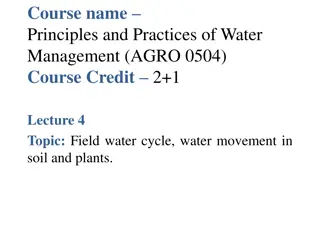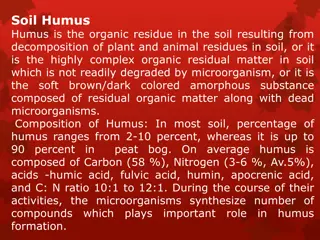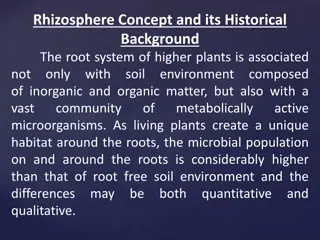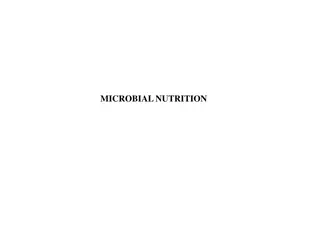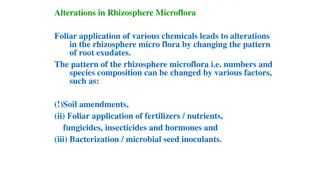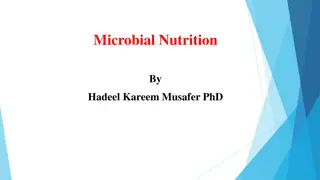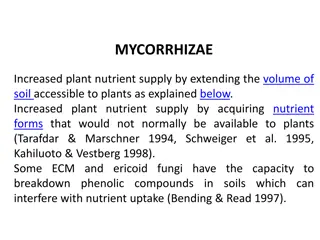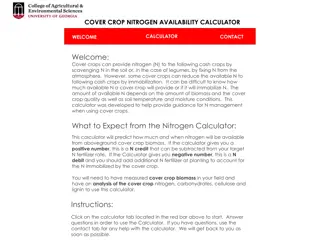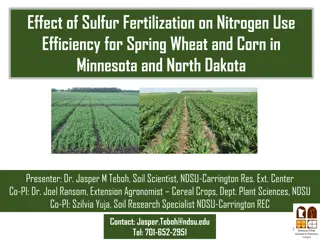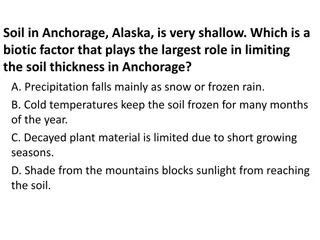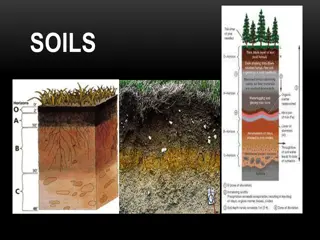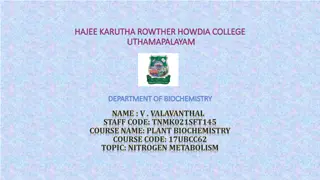Microbial Transformations of Nitrogen in Soil: Factors, Forms, and Impact on Plant Nutrition
Understanding the microbial transformations of nitrogen in soil is crucial for optimizing plant nutrition. Factors such as climate, water supply, cultivation, soil texture, and depth influence the nitrogen content in soil. The different forms of soil nitrogen, including inorganic and organic compounds, play vital roles in soil fertility. Plants primarily absorb nitrogen in the forms of NH4+ and NO3-, with nitrate being the dominant source. The process of mineralization converts organic nitrogen into mineral forms, such as NH4+, NO3-, and NO2-. This knowledge is essential for efficient nutrient management in agricultural systems.
Download Presentation

Please find below an Image/Link to download the presentation.
The content on the website is provided AS IS for your information and personal use only. It may not be sold, licensed, or shared on other websites without obtaining consent from the author.If you encounter any issues during the download, it is possible that the publisher has removed the file from their server.
You are allowed to download the files provided on this website for personal or commercial use, subject to the condition that they are used lawfully. All files are the property of their respective owners.
The content on the website is provided AS IS for your information and personal use only. It may not be sold, licensed, or shared on other websites without obtaining consent from the author.
E N D
Presentation Transcript
MICROBIAL TRANSFORMATIONS OF NITROGEN
Introduction Source of Nitrogen used by the plants is inert gas which constitutes about 78% of earthsatmosphere The ploughed layer of majority of cultivated soils contain 0.02% to 0.04% ofN Indian soils have very low Nitrogen contain because of low organic matter accumulation due to tropicalclimate. Soils developed under humid climate higher N content than those formed under dryclimate. On an average black soil(0.08%) than redsoils(0.05%)
Factors Effecting the content of N inSoil 1. Climate i. Temperature: Lower the temperature higher is the N content due to more organic matter addition and slow decomposition. ii. Water supply: Soil N content increases with water supply up to fieldcapacity. 1. Effectofcultivation: N content decreases with cultivation due to organic matter loss through decomposition. 3. Soiltexture: Finerthetexture,higheristheN content. 4. Depth in theprofile: Surface soilhas more N content than deepersoils. rate of
Forms of soilnitrogen: The total nitrogen content of soils ranges from less than 0.02 % in sub soils to more than 2.5 % in peat soils. The N present in soil can generally be classed as inorganic (around 2 %) and organic (around 98 %). 1. Inorganic nitrogen compounds: The inorganic forms of soil nitrogen include ammonium (NH4 + ), nitrate (NO3 -), nitrite (NO2 -), nitric oxide (NO) nitrous oxide (N2O) and elemental nitrogen. NH4 + ,NO3 -and NO2 -are important in soil fertility and represent 2 to 5 % of total nitrogen. 2. Organic nitrogen compounds : occur as consolidated amino acids or proteins, free amino acids, amino sugars and other unidentified compounds like materials that result from the reaction of NH4 + with lignin, polymerisation of quinones and nitrogen compounds, the condensation of sugars and amines. Bound amino acids are to the extent of 20-40 %,amino sugars (hexosamines) 5 to 10 % purine and pyrimidine derivatives 1 % or less
N Transformations in soil: Plants absorb most of the N in the NH4 + and NO3 -forms. Nitrate is the dominant source as its concentration is higher than NH4 + and it is free to move to theroots. Potatoes, sugarbeet, pine apple, prefer both theforms; Tomatoes, celery, bush beans, prefer NO3 -, Rice and blue berriespreferNH4+ . NO3 --N uptake is usually high and is favoured by low pH conditions. NH4 + -N is less subjected to losses by leaching and denitrification. NH4 + uptake is best at neutral pH values. When the plants are supplied with NH4 + -N,it leadsto acidityin thesoil.
Mineralization of N compounds: N mineralization is simply the conversion of organic nitrogen to mineral form (NH4 + , NO3 -, and NO2 -). When organic residues having a C: N ratio wider than 30 are added to the soil, immobilisation of nitrogen takes place.If C:N ratio is narrow i.e., less than 20 mineralisation is theresult. (for legume residues), It takes place essentially by threesteps. 1. Aminisation 2. Ammonification
1. Aminisation: Heterotrophic soil microbes,mostly,bacteria like Pseudomonas and Bacillus are believed to dominate in the break down of proteins in neutral and alkaline soils. Under acidic conditions fungi prevail. In this step hydrolytic decomposition of proteins and release of amines and amino acids takes place. 2. Ammonification : The amines and amino acids so released are further utilized by still other groups of heterotrophs with the release of ammoniacal compounds. The step is termed as ammonification. R-NH2 + HOH NH3 + R OH + Energy. NH3 + H2O NH4 + + OHThe ammonium thus formed may be nitrified to nitriteand nitrate which are used byplants.
Ammonium fixation The presenceofK+ (ionic diameterof2.680A)willoften restrictNH4 + fixation since this ion can also fill fixation sites.Consequently it has been suggested that K fertilization prior to NH4 + application is a practicalway ofreducing NH4+ fixation. In agriculture soils 5-20% of total N is found as fixed ammonium ion with an average of10% Factors affecting ammoniumfixation 1. Type and amount of clay: NH4 + fixation increases with increase inthe content particularly 2:1 vermiculite,finegrained mica andsmectite. 2. Moisture content of the soil: temperature of the soil will affect the fixation of NH4 +. Freezing and drying increases the fixation. Alternate cycles of wetting and drying; freezing and thawing are believed to contribute to the stabilityofrecentlyfixed NH4+ 3. Amount of K+ : The presence of K+ will restrict NH4 + fixation sinceK + also fills thefixationsites type of clay minerals like The moisture content and
. 4.. Depth of the soil:Fixation of NH4 + is generally higher in sub soil than surface soil due to higher clay content and lower rate ofnitrification. 5.Organic matter content : Higher the organic matter content moreis theNH4+ fixation. 6.Population of nitrifying bacteria : Nitrifying bacteria oxidize NH4+ to nitriteand nitrates thus reducing thechances for NH4 + fixation
Nitrification The biological oxidation of NH4 + released by the process of ammonification to nitrate is known asnitrification. This process is carried out by nitrifying bacteria referred to asnitrifiers. Itis a twostepprocess in which NH4 + is firstconverted tonitrite (NO2 -) and then to nitrate (NO3 - ). Conversion to nitrite is brought about largely by a group of obligate autotrophic bacteria known as Nitrosomonasas Theconversion from nitriteto nitrateis affected by Nitrobacter as follows:
Factors affecting nitrification Supply of the ammonium ion : Because the substrate for the nitrifying bacteria is the ammonium ion,a supply of this ion is the first requirement for nitrification. Population of nitrifying organisms : Undersimilar conditions of temperature, moisture and added ammonia, the nitrification is greatly influenced by population of nitrifyingbacteria. Soil reaction : Nitrification takes place between pH of 5.5 to 10.0, with an optimum around8.5. Soil aeration : The nitrifying bacteria are anaerobes and hence require sufficient oxygensupply.
Soil moisture : The rate at which nitrification proceeds in a soil is governed to a marked extent by the water content being retarded by both very low or veryhigh moisturecontent. Temperature :Verylow nearerfreezing andincreasesrapidlyupto 35oC. C : N ratio :when organic residues with wide C :N ratio are added,general purposedecay organisms are dominantand nitrifiers becomeinactive. Pesticides : Nitrifying organisms are quite sensitiveto somepesticides.
Denitrification Denitrification is a process limited to anoxic soils in which bacterialreduction of NO3 -and NO2 -takes place leading to the release of NO, N2O and N2 gases. When soils become water logged, oxygen is excluded decompositiontakesplace. Some anaerobic organisms have the ability to obtain their oxygen from nitrates and nitrites with the accompanyingrelease ofnitrousoxide and nitrogen. The most probable biochemical pathway leading to these losses is indicated as and anaerobic
Facultative anaerobic bacteria belonging to the genera Pseudomonas, Bacillus denitrificans and Paracoccus are responsible forthis. Autotrophs like Thiobacillus denitrificans also brings aboutdenitrification. Nitrification inhibitors Several products have been developed with the purpose of slowing the release and/or nitrification of applied N to synchronise the supply of N with the crop demand and consequently decrease nitrogen losses via leaching and / or denitrification. These chemicals restrict the growth of Nitrosomonas and keep nitrogen in NH4+ form. Natural nitrification inhibitors : Neem cake (Azadiracta indica) Karanj cake (Pongamia glabra)Neem oiland nimin Chemical nitrification inhibitors N : serve or nitrapyrin Hydroquinone,Calcium carbide(CaC2)
Nitrogen immobilization Immobilisation of nitrogen is the reverse of mineralisation and it occurs when large quantities of low nitrogen crop residues with wide C:N ratio (>30:1) such as coconut coir or cereal straw begin decomposing in soil,the high amounts of carbohydrates in such residues cause the microbialpopulation to build upquickly. As new cells are formed,nitrogen and other essential elements from soil are used to build protoplasm. This leads to a decrease in the levels of inorganic nitrogen for crops. A shortageofnitrogen can be avoided in such situations by supplying enough fertilizer nitrogen to compensate for immobilization and to meet the crop requirements. This lockup ofinorganic N ofsoilis temporaryand slowlywillbe released after
Biological Nitrogen Fixation Bacteria are capable of reducing nitrogen to ammonia with the help of an enzyme called nitrogenase. The process is known as biological nitrogen fixation(BNF). They contribute 140-170 MT N/yr whereas N input through fertilizer is only 65 MTN/yr. Different groups of N2 fixers: Therearethreemaingroups ofN2fixers as given below : I. Symbiotic : Symbiotic nitrogen fixers reduce nitrogen in association with plants by forming some specialized structures inplants. a) Legume rhizobium symbiosis : Some plants of leguminosae family form a symbiotic associationwithbacteria with thegenus Rhizobium whichfixatmospheric nitrogen. Rhizobia infect the root moving to the root cortex through an infection thread which results in the formation of a tiny outgrowth called rootnodule. Sesbania rostrata forms nodules on the stem as well. This association is host specific. TheRhizobia turn to bacteroids which have nitrogenase enzyme embedded intoleghaemoglobin.
The symbiotic association of the host and the bacterium is mutually beneficial to both organisms. Specific species of bacterium infects the roots of a particular group of legumes. Crops nodulatedbysingleRhizobium sp.is referredto as cross inoculationgroup .
b)Symbiosis with nonlegumes Frankia symbiosis The member actinomycetes,the Frankia forms symbiosis with forest trees belonging to the families Myricaceae. Casuarinaceae and Azolla is a fresh water fern found floating on the surface of water. All the species of Azolla have an algal symbiont called Anabaena azollaein aspecialized cavityin theupperleafsurface. In ricefields the symbiosis can fixN2 upto 30-40 kg N ha-1. 2.. Non specific associative N2 fixers: Rhizobacteria like Azospirillum, Pseudomonas etc. These bacteria are capable of using exudates of roots as the source ofenergy. Acetobacter, Azotobacter, Flavobacterium,
3.Free living nitrogen fixers reducing molecular N2 to NH4 + without forming any association with plants. They supply about 10-15 kg N ha-1. They also function as plant growthpromotingrhizobacteria(PGPR). : Many soil bacteria are capable of


